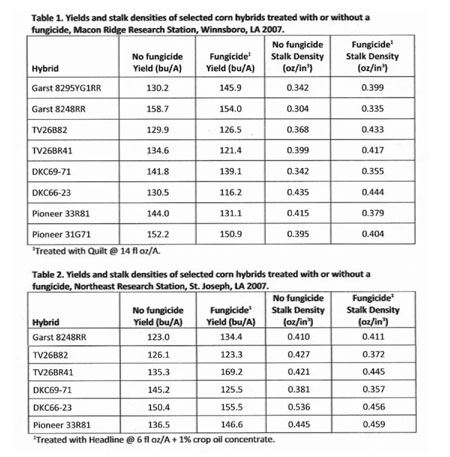The Impact Of Fungicides On Corn Produced In The Mid-South
Fungicides are used in many crops produced in the Mid-South; however, it wasn’t until recently
this practice was promoted in corn. Even though plant residues in reduced tillage systems can
harbor plant pathogens, it is not known if fungicides will increase the productivity of corn.
Therefore, research was initiated across the Mid-South to evaluate this practice. Research in
Louisiana was conducted at selected experiment stations (Dean Lee, Macon Ridge and Northeast Research
Stations) and producer fields. The objectives were to: 1. Determine if selected fungicides are
effective for managing corn diseases in Louisiana; 2. Determine if yields are higher in fungicide treated
corn than in non-treated corn; and 3. Determine if stalk density in fungicide-treated corn is
greater than non-treated corn.
Macon Ridge and Northeast Research Stations: In 2007 and 2008 Quilt and Headline fungicides
were evaluated. In 2007, eight and six hybrids were evaluated at the Macon Ridge Research Station
and Northeast Research Station, respectively. A single application was made to each variety while
in the tasseling growth stage (VT) and compared to the corresponding non-sprayed variety. Plots
were monitored periodically for diseases and rated for incidence and severity if present. Stalk density
was assessed when corn reached the black layer growth stage (physiological maturity). Yield and
test weights were also recorded.
Diseases (rusts and blights) either did not develop or developed late season in both years. Therefore,
the impact of fungicides on disease development could not be determined. In 2007, stalk density
and yields varied within and across hybrids (Tables 1 and 2). At the Macon Ridge location, yield
differences between hybrids treated with Quilt (14.0 fl oz/A) and non-treated hybrids ranged from
15.7 bu/A to -14.3 bu/A, and averaged 4.6 bu/A less across the treated hybrids. Yield differences
between hybrids treated with Headline (6.0 fl oz/A) and non-treated hybrids ranged from 33.9 bu/A
to -19.7 bu/A and averaged 6.3 bu/A more in Headline-treated plots. Results from the test conducted
at the Northeast Research Station in 2008 were similar to those in 2007. A range in yield differences
of 11.4 bu/A to -4.3 bu/A between Headline-treated hybrids and non-treated hybrids was
observed (Table 3). Corn treated with Headline averaged 2.3 bu/A more than non-treated hybrids.
No effects on stalk densities and test weight were observed among most hybrids.
Dean Lee Research Station and Off-Station: During 2007, Headline (6.0 fl oz/A), Quilt (14.0 fl
oz/A), Quadris (6.0 fl oz/A), and Stratego (10.0 fl oz/A) were evaluated in 21, 26, 3, and 9 tests, respectively.
Producer tests usually consisted of large areas in fields either treated with a fungicide or
left non-treated. Twenty-one corn hybrids were evaluated. A single application was made to corn at
or near tasseling. Disease epidemics did not develop to appreciable levels in most tests. However,
where diseases were observed, incidence and severity was lowest in fungicide-treated corn. When
averaged across tests and compared to non-treated corn, yields were 0.89 bu/A, 0.06 bu/A, and
2.38 bu/A higher in corn receiving an application of Headline, Quilt, or Quadris, respectively (Table
4). The average yield of corn treated with Stratego was 1.35 bu/A less than non-treated corn. Even
though yield response was minimal or nonexistent, responses from individual hybrids varied considerably.
Yield differences ranged between fungicide-treated hybrids and non-treated hybrids by 12
bu/A to -20.4 bu/A for Headline, 14.9 bu/A to -17.2 for Quilt, 9.0 bu/A to -5.3bu/A for Quadris,
and 10.7 bu/A to -27.7 bu/A for Stratego.
Summary: The impact of fungicides on disease could not be determined since disease epidemics
did not develop to significant levels in most tests. Fungicides did not preserve stalk densities or increase
test weights among most hybrids. The impact of fungicides on yield was not consistent among
hybrids or across years. Yields of 6 bu/A or higher were observed in 33% of tests including Headline
or Quadris, 27% of the tests including Quilt, and 50% of the tests including Stratego when
compared to non-treated corn. These inconsistent responses do not support the practice of automatically
applying fungicides to corn. In areas where disease epidemics may develop to damaging
levels, the probability of an economic return from a fungicide application may increase.
